
WPG/WAGC/WHEC-37, launched as USCGC Roger B. Taney and for most of her career called USCGC Taney, is a United States Coast Guard High Endurance Cutter notable as the last warship floating that fought in the attack on Pearl Harbor. She was named for Roger B. Taney (1777–1864), who served as U.S. Attorney General, Secretary of the Treasury, and Chief Justice of the United States.
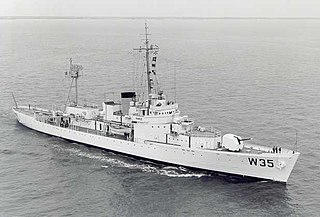
USCGC Ingham (WPG/WAGC/WHEC-35) is one of only two preserved Treasury-class United States Coast Guard Cutters. Originally Samuel D. Ingham, she was the fourth cutter to be named for Treasury Secretary Samuel D. Ingham. She was the most decorated vessel in the Coast Guard fleet and was the only cutter to ever be awarded two Presidential Unit Citations.

The USCGC Bibb (WPG-31) was a 327-foot (100 m) Secretary-Class Coast Guard ship commissioned in 1936. Seven similar "combat cutters" were built and named for secretaries of the United States Treasury. Bibb was named for U.S. Secretary of the Treasury George M. Bibb.
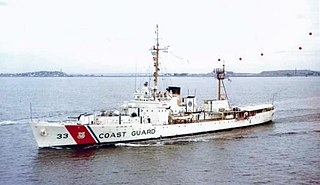
The Treasury-class cutter was a group of seven high endurance cutters launched by the United States Coast Guard between 1936 and 1937. The class were called the "Treasury class" because they were each named for former Secretaries of the Treasury. These ships were also collectively known as the "327's" as they were all 327 feet (100 m) in length. The Treasury-class cutters proved versatile and long-lived warships. Most served the United States for over 40 years, including with distinction through World War II, Korea, and Vietnam.

The USCGC Morgenthau (WHEC-722), was the eighth of twelve 378-foot dual-powered turbine/diesel Hamilton-class high endurance cutters (WHECs) built by Avondale Shipyards in New Orleans, Louisiana. The Coast Guard commissioned the Morgenthau on March 10, 1969. After 48 years of continuous service the U.S. Coast Guard decommissioned the Morgenthau on April 18, 2017, and the ship was sold to Vietnam. On 27 May 2017 the Vietnam Coast Guard commissioned the former cutter as patrol ship CSB 8020.
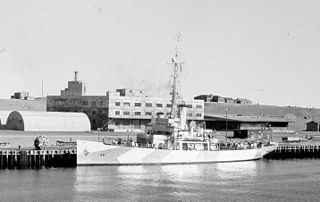
USCGC Modoc (WPG-46) was a 240-foot Tampa-class United States Coast Guard cutter designed for multi-mission roles. She had a top speed of sixteen knots, and was armed with a pair of 5-inch deck guns. With the breakout of war she was armed with depth charges, additional guns, sonar, and radar and transferred to the Navy. Modoc, along with her sister ships Mojave and Tampa joined the Greenland Patrol.

USS Biscayne (AVP-11), later AGC-18, was a United States Navy Barnegat-class seaplane tender in commission as a seaplane tender from 1941 to 1943 and as an amphibious force flagship from 1943 to 1946. She saw service during World War II. Transferred to the United States Coast Guard after the war, she was in commission as the Coast Guard cutter USCGC Dexter (WAGC-385), later WAVP-385 and WHEC-385, from 1946 to 1952 and from 1958 to 1968.

USS Cook Inlet (AVP-36) was a United States Navy Barnegat-class small seaplane tender in commission from 1944 to 1946. She tended seaplanes during World War II in the Pacific and earned one battle star for her service. After the war, she was transferred to the United States Coast Guard, and was in commission as the Coast Guard cutter USCGC Cook Inlet (WAVP-384), later WHEC-384, from 1949 to 1971. She saw service in the Vietnam War during her Coast Guard career, receiving two campaign stars for her operations during the conflict. Transferred to South Vietnam in 1971, she operated as the Republic of Vietnam Navy frigate RVNS Trần Quốc Toản (HQ-06) until South Vietnam's collapse in April 1975 at the end of the Vietnam War. She fled to the Philippines and in 1976 was transferred to the Philippine Navy, which never commissioned her, instead using her as a source of spare parts for her sister ships, the Andrés Bonifacio-class frigates, before discarding her in 1982.

USS Unimak (AVP-31) was a United States Navy Barnegat-class small seaplane tender in commission from 1943 to 1946 that saw service in World War II. After the war, she was in commission in the United States Coast Guard as the cutter USCGC Unimak (WAVP-379), later WHEC-379, WTR-379, and again WHEC-379, from 1949 to 1975 and from 1977 to 1988.

USCGC Campbell (WPG-32) was a 327-foot (100 m) Secretary-class United States Coast Guard ship built at the Philadelphia Navy Yard in 1935-1936 and commissioned in 1936. Seven similar "combat cutters" were built and named for secretaries of the United States Treasury.

USCG Owasco (WHEC-39) was an Owasco class high endurance cutter which served with the US Coast Guard from 1945 to 1973. Originally intended for World War II service, she was commissioned only weeks before the end of the war and consequently did not see combat until her deployment in the Vietnam War more than 20 years later.

USCGC Wachusett (WHEC-44) was an Owasco-class high endurance cutter built for World War II service with the United States Coast Guard. She was commissioned too late for service in that war and consequently did not see wartime service until the Vietnam War.
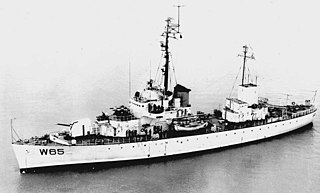
USCGC Winona (WHEC-65) was an Owasco class high endurance cutter built for World War II service with the United States Coast Guard. The war ended before the ship was completed and consequently she did not see wartime service until the Vietnam War.

USCGC Androscoggin (WHEC-68) was an Owasco-class high endurance cutter built for World War II service with the United States Coast Guard. The war ended before the ship was completed and consequently Androscoggin did not see wartime service until the Vietnam war.
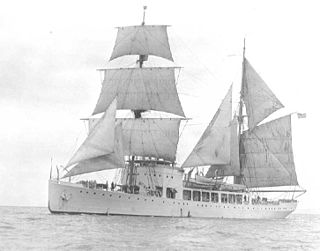
USCGC Northland (WPG-49) was a United States Coast Guard cruising class of gunboat especially designed for Arctic operations in commission from 1927 to 1938 and from 1939 to 1946. She served during World War II. She was the last cruising cutter built for the Coast Guard equipped with a sailing rig.

USS Half Moon (AVP-26) was a seaplane tender that in commission in the United States Navy from 1943 to 1946 that saw service in the latter half of World War II. After the war, she was in commission in the United States Coast Guard as the cutter USCGC Half Moon (WAVP-378), later WHEC-378, from 1948 to 1969, seeing service in the Vietnam War during her Coast Guard career.

The second USS Barataria (AVP-33) was a United States Navy Barnegat-class seaplane tender in commission from 1944 to 1946. She saw service in the later stages of World War II and was decommissioned postwar. She then was transferred to the United States Coast Guard and was in commission as the Coast Guard cutter USCGC Barataria (WAVP-381), later WHEC-381 from 1949 to 1969, serving in the Cuban Missile Crisis and the Vietnam War during her lengthy Coast Guard career.

USCGC Spencer (WPG-36) was a Treasury-class cutter of the United States Coast Guard that served during World War II. She was named for U.S. Treasury Secretary John Canfield Spencer.

The Casco class was a large class of United States Coast Guard cutters in commission from the late 1940s through the late 1980s. They saw service as weather reporting ships in the Atlantic and Pacific Oceans until the early 1970s, and some saw combat service during the Vietnam War.

The USCGC North Star was a United States Coast Guard Cutter during the Second World War. It was originally built for the U.S. Interior Department and served in the United States Coast Guard (USCG) before being acquired by the U.S. Navy.

























